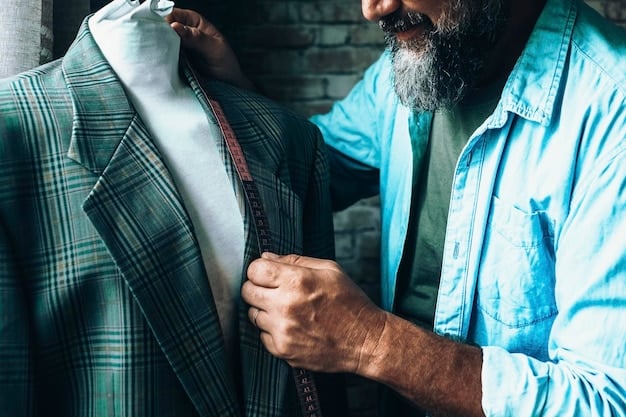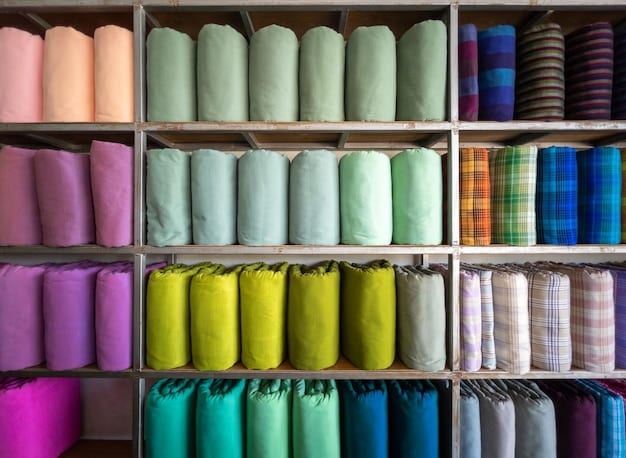Urban Style Guide: Mastering Fit for Maximum Impact

In urban style, fit is paramount; tailoring your clothes for maximum impact ensures a polished, confident look, transforming off-the-rack pieces into personalized statements of style.
In the realm of urban fashion, where self-expression reigns supreme, the perfect fit is the cornerstone of a remarkable style. Urban Style Guide: The Importance of Fit – Tailoring Your Clothes for Maximum Impact reveals the transformative power of well-fitted clothing, turning everyday outfits into statements of confidence and style.
Why Fit Matters in Urban Style
In urban style, fit is not just about comfort; it’s a powerful form of self-expression. Clothes that fit well enhance your silhouette, project confidence, and create a polished look that sets you apart in the urban landscape.
Confidence Booster
Clothes that fit well instantly boost your confidence. When your clothes accentuate your best features, you feel more comfortable and self-assured, which radiates in your demeanor.
Polished Look
A well-fitted outfit looks infinitely more polished than baggy or ill-fitting clothes. It shows attention to detail and a commitment to presenting yourself in the best possible light.
Expression of Individuality
Fit allows you to express your individuality. Tailoring clothes to fit your unique body shape demonstrates that you care about your personal style and are willing to go the extra mile to achieve it.

Here are some ways to think about fit:
- Shoulder Fit: The shoulder seams should lie flat and align with the edge of your shoulders.
- Sleeve Length: Sleeves should end where your wrist meets your hand. Too long or too short sleeves can throw off the entire look.
- Torso Fit: The torso of a jacket or shirt should be snug but not tight, allowing for comfortable movement.
- Trouser Break: The break is the amount of fabric that folds over your shoes. A slight break is generally considered modern and stylish.
Ultimately, understanding why fit matters in urban style elevates your fashion game. It turns simple clothes into a mirror reflecting your individuality and confidence.
Understanding Body Types for Optimal Fit
To achieve a perfect fit, it’s essential to understand your body type. Different body shapes require different cuts and styles of clothing, so knowing your body type is the first step toward dressing well.
Identifying Your Body Type
There are several common body types, including:
- Rectangle: Shoulders and hips are roughly the same width, with little waist definition.
- Triangle or Pear: Hips are wider than shoulders.
- Inverted Triangle: Shoulders are wider than hips.
- Oval or Apple: Weight is carried mostly around the midsection.
- Hourglass: Shoulders and hips are roughly the same width, with a defined waist.
Clothing Strategies for Each Body Type
Once you’ve identified your body type, you can start selecting clothes that flatter your shape.
Rectangle:
- Opt for clothes that add shape and definition, such as layered outfits or pieces with structured shoulders.
- Belts can help create the illusion of a waist.
Triangle or Pear:
- Choose clothes that balance your proportions, such as wide-leg trousers or A-line skirts.
- Draw attention to your upper body with bright colors or bold patterns.
Inverted Triangle:
- Select clothes that balance your wider shoulders, such as straight-leg trousers or full skirts.
- Avoid shoulder pads or overly structured tops.
Oval or Apple:
- Choose clothes that skim your body without clinging, such as empire-waist tops or A-line dresses.
- Vertical stripes can create a slimming effect.
Hourglass:
- Emphasize your waist with fitted clothes, such as wrap dresses or tailored blazers.
- Avoid boxy or shapeless clothes that hide your curves.
Knowing your body type and dressing accordingly will significantly enhance your urban style. Embrace your shape and choose clothes that make you feel confident and comfortable.
The Art of Tailoring: Key Adjustments for a Perfect Fit
Tailoring is a crucial element in achieving the perfect fit. It involves modifying clothing to fit your body specifically, addressing issues like length, width, and overall shape. Knowing what adjustments to make can transform an off-the-rack piece into a custom-fitted garment.
Essential Tailoring Adjustments
These are some tailoring adjustments that can dramatically improve the look and fit of your clothes:
- Taking in or Letting Out: Adjusting the width of a garment to fit your waist or chest more closely.
- Hemming: Shortening trousers, skirts, or dresses to the ideal length.
- Sleeve Adjustments: Altering the length or width of sleeves for a more refined look.
- Shoulder Adjustments: Correcting the fit of shoulders on jackets or shirts to eliminate bunching or drooping.
- Dart Adjustments: Adding or removing darts to shape the garment to your body’s contours.
Finding a Good Tailor
A skilled tailor is invaluable in your quest for the perfect fit. To find a good tailor:
- Ask for Recommendations: Seek referrals from friends, family, or local fashion boutiques.
- Read Reviews: Check online reviews to assess the tailor’s reputation and quality of work.
- Check Their Portfolio: Ask to see examples of their work to gauge their expertise and attention to detail.
- Communicate Clearly: Clearly explain your desired alterations and ensure the tailor understands your vision.
When to Tailor
Knowing when to tailor a garment can save you money and ensure you always look your best. Here are some guidelines:
- Investment Pieces: Tailor high-quality, classic pieces that you plan to wear for years to come.
- Sales Bargains: If you find a great deal on a garment that doesn’t fit perfectly, tailoring can make it wearable.
- Unique Finds: Vintage or unique pieces often require tailoring to fit modern body shapes.
With the right adjustments and a skilled tailor, you can transform your wardrobe and elevate your urban style.
Choosing the Right Fabrics for Optimal Fit
Fabric plays a significant role in how well clothes fit and drape on your body. Different fabrics have different weights, textures, and stretch characteristics, which can affect the overall look and feel of an outfit. Understanding the properties of various fabrics can help you choose clothes that fit well and flatter your figure.

Understanding Fabric Properties
Here are some common fabric properties to consider when choosing clothes:
- Weight: Lightweight fabrics like silk and linen drape softly, while heavier fabrics like wool and denim hold their shape.
- Texture: Smooth fabrics like satin and microfiber create a sleek look, while textured fabrics like corduroy and tweed add interest and depth.
- Stretch: Fabrics with stretch, such as spandex blends, conform to your body’s curves and provide comfort and flexibility.
- Drape: Drape refers to how a fabric hangs on your body. Fabrics with good drape flow smoothly and enhance your silhouette.
Fabrics for Different Body Types
Different fabrics flatter different body types. Some of the considerations:
- Lightweight Fabrics: If you’re bottom heavy, lightweight fabrics like silk, chiffon, and linen will add a soft, flowing feel to your outfits.
- Structured Fabrics: For those with rectangle shaped bodies or those who want garments that hold their shape, consider structured fabrics such as cotton, denim, and wool.
- Medium-Weight Fabrics: Those with hourglass figures can emphasize their curves without the fabric clinging to their skin while using medium weight fabrics such as jersey, crepe, and ponte knit.
Seasonal Fabric Choices
Different fabrics are more suitable for different seasons. Consider these guidelines:
- Spring/Summer: Lightweight, breathable fabrics like cotton, linen, and silk are ideal for warm weather. They keep you cool and comfortable while providing a stylish look.
- Fall/Winter: Heavier, warmer fabrics like wool, corduroy, and velvet are perfect for cold weather. They provide insulation and add a touch of luxury to your outfits.
Choosing the right fabrics is essential for achieving a perfect fit and creating a stylish, comfortable urban wardrobe.
The Psychology of Fit: Confidence and Self-Perception
The way clothes fit can significantly impact your confidence and self-perception. When your clothes fit well, you feel more comfortable, attractive, and in control, which can lead to a positive self-image and increased self-esteem. Understanding the psychology of fit can help you harness the power of clothing to enhance your overall well-being.
The Link Between Fit and Confidence
Clothes that fit well can boost your confidence in several ways:
- Improved Body Image: Well-fitted clothes accentuate your best features and minimize perceived flaws, leading to a more positive body image.
- Enhanced Comfort: Comfortable clothes make you feel more at ease and confident in your own skin.
- Positive Self-Perception: When you look good, you feel good, which can improve your overall mood and self-esteem.
The Effects of Ill-Fitting Clothes
On the other hand, ill-fitting clothes can have negative effects on your confidence and self-perception:
- Self-Consciousness: Clothes that are too tight or too baggy can make you feel self-conscious and uncomfortable.
- Negative Body Image: Ill-fitting clothes can exaggerate perceived flaws and lead to a negative body image.
- Reduced Confidence: Feeling uncomfortable in your clothes can diminish your confidence and make you less likely to engage in social situations.
Tips for Boosting Confidence Through Fit
Here are some tips for using fit to boost your confidence:
- Know Your Measurements: Regularly measure yourself to ensure you’re buying clothes in the correct size.
- Prioritize Fit Over Fashion: Choose clothes that fit well over trendy styles that don’t flatter your figure.
- Embrace Tailoring: Invest in tailoring to customize your clothes for a perfect fit.
- Experiment with Styles: Try different styles and cuts to find what makes you feel most confident and comfortable.
By understanding the psychology of fit and making conscious choices about your clothing, you can harness the power of fashion to enhance your confidence and self-perception.
Maintaining the Perfect Fit: Care and Storage Tips
Maintaining the perfect fit of your clothes requires proper care and storage. The way you clean, dry, and store your garments can significantly impact their shape, size, and overall appearance. By following these tips, you can extend the life of your wardrobe and ensure your clothes always look their best.
Laundry Tips for Preserving Fit
Here are some laundry tips to help preserve the fit of your clothes:
- Read Care Labels: Always read and follow the care instructions on garment labels.
- Wash in Cold Water: Cold water is gentler on fabrics and helps prevent shrinking and fading.
- Use Mild Detergent: Harsh detergents can damage fibers and cause clothes to lose their shape.
- Avoid Overloading the Washer: Overloading can prevent clothes from getting properly cleaned and can stretch or damage them.
Drying Techniques
Proper drying techniques are essential for maintaining the fit of your clothes:
- Air Dry When Possible: Air drying is the gentlest method and helps prevent shrinking.
- Use Low Heat: If you must use a dryer, use the lowest heat setting possible.
- Remove Promptly: Remove clothes from the dryer as soon as they’re dry to prevent wrinkles and shrinking.
Storage Solutions
The way you store your clothes can also affect their fit and appearance:
- Hang Properly: Use padded hangers to prevent shoulder bumps and maintain the shape of delicate garments.
- Fold Correctly: Fold clothes neatly to prevent wrinkles and creases.
- Store in a Cool, Dry Place: Store clothes in a cool, dry place away from direct sunlight to prevent fading and damage.
Regular Maintenance
Regular maintenance can help preserve the fit of your clothes:
- Check for Damage: Regularly inspect your clothes for loose buttons, tears, or stains, and repair them promptly.
- Steam or Iron: Steam or iron your clothes to remove wrinkles and maintain a polished look.
By following these care and storage tips, you can ensure your clothes maintain their perfect fit and continue to enhance your urban style for years to come.
| Key Point | Brief Description |
|---|---|
| 📏 Importance of Fit | Fit enhances confidence and style. Clothes should accentuate your physique. |
| 🧵 Art of Tailoring | Tailoring perfects garment fit to your body shape. |
| 👕 Fabric Selection | Fabrics affect fit and drape. Consider weight, texture, and stretch. |
| 🧺 Garment Care | Proper laundering and storing maintain garment shapes and sizes. |
Frequently Asked Questions
▼
Fit is paramount because it elevates your overall look. Well-fitted clothing enhances confidence and shows attention to personal style, which defines urban fashion.
▼
Identify your body type by assessing shoulder, waist, and hip measurements. Common types include rectangle, triangle, inverted triangle, oval, and hourglass, each benefiting from specific cuts and styles.
▼
Key tailoring adjustments include taking in or letting out seams, hemming lengths, sleeve adjustments, and shoulder corrections. These tweaks ensure clothes fit your body perfectly.
▼
Fabrics influence drape and structure. Lightweight fabrics flow softly, while heavier fabrics hold shape. Stretch fabrics offer comfort and flexibility, affecting how clothes contour to your body.
▼
Wash clothes in cold water with mild detergent, air dry when possible, and store garments in a cool, dry place. Proper hanging and folding also help preserve shape and prevent damage.
Conclusion
Mastering the art of fit is essential for achieving a polished and confident urban style. By understanding your body type, choosing the right fabrics, and utilizing tailoring services, you can transform your wardrobe and express your unique personality through well-fitted clothing.





